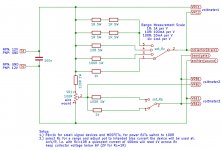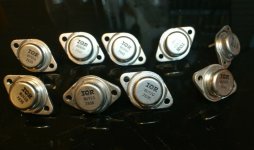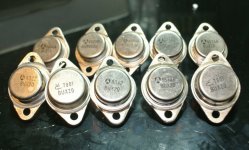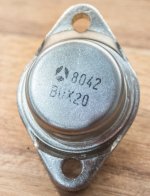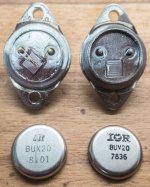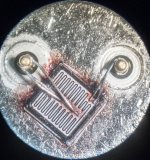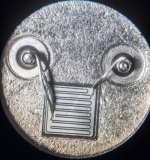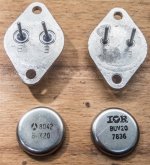I got sidetracked trying to finish up my main system.
Once I get back to it the pre will be a NAC32, although I'm later going to clone that too. I have a pair of Linn Isobariks in the attic, so I'll probably start with those.
Once I get back to it the pre will be a NAC32, although I'm later going to clone that too. I have a pair of Linn Isobariks in the attic, so I'll probably start with those.
The design doesn't generate much heat; I'd go with the second. Plus, it looks very distinctive.
Thanks 🙂
I finally managed to get hands on some 40 genuine but vintage power transistors from a trusted source. They have the much thicker base plate, and some of them have solder remainings on their legs. So I need to test them. I looked around the forum and found this post. As far as I understood testing / matching can be done by simply putting resistors around the transistor and feeding current to it, then mesauring Vbe (voltage between base and emitter) and voltage across the resistors and calculate gain like this: hFE=(VRc/Rc)*(Rb/VRb). I copied the circuit from this article and intend to build a simple power transistor tester:
Of course I would use a good regulated power supply and fix the transistors during test with some kind of clamp to a heatsink. Please let me know if I am on the right track!
Attachments
I finally managed to get hands on some 40 genuine but vintage power transistors from a trusted source.
Can you name the source of your transistors? Does it have more of them?
I bought from different sources, but one guy on Ebay sold BUX20/BUV20 from old stock, some of them were pulled, I need to test them - sorry I bought all of them (see attached pictures). Another set of BUX20s I got from here, they look exactly like the ones offered here on Ebay and came with the same paperwork and matched drivers. The set I posted photos of earlier I ordered from here, but I doubt they are genuine. BUV21 are in stock at Mouser!
Attachments
BUV21 is a darlington of course.
What’s with using these old transistors like BUV20? You might be better using low capacitance/high ft modern types.
What’s with using these old transistors like BUV20? You might be better using low capacitance/high ft modern types.
You might be better using low capacitance/high ft modern types.
Do you have recommendations in plastic or TO3...?
I have been using the original PT77 transistors, as in the old Cyrus 2. Other seem to have used - besides of the already mentioned Sanken transistors - the BUV48A. I recently dismantled one of my older Naim clones and will try to renew it with better pcb boards (since they had all the other stuff pretty much original, transistors, caps, etc. )
I possibly do not have any suitable TO3 transistors for the "Young" boards yet. The BUV20 I have bought from ebay are very possibly fakes (they look like yours, jpk73). I do actually have MJ15003 from Onsemi, but they seem to be rather slow compared to the later Naim transistors (as far as JV has told us...). If I do not find any better I will try to implement these first.
I possibly do not have any suitable TO3 transistors for the "Young" boards yet. The BUV20 I have bought from ebay are very possibly fakes (they look like yours, jpk73). I do actually have MJ15003 from Onsemi, but they seem to be rather slow compared to the later Naim transistors (as far as JV has told us...). If I do not find any better I will try to implement these first.
The 15003s sounded a bit thin and sharp. The "fake" BUV20s I tried sounded way better, but I think they are rebranded trannies: measuring through them with the above circuit showed extrem different numbers for some of them...
The MJ15022 is a TO-3 of a similar, if not better spec.I guess the MJL21194 are very suitable for the job (TO-264). They have been very useful in restoring older amplifiers, or even newer ones with "classical" circuits (f.e. Nytech).
The MJ15003 are twice the capacitance of MJ15022 and about a third of the ft, according to the ON-Semi datasheets.The 15003s sounded a bit thin and sharp. The "fake" BUV20s I tried sounded way better, but I think they are rebranded trannies: measuring through them with the above circuit showed extrem different numbers for some of them...
Maybe your MJ15003 were from ebay too? Mine did sound pretty good in a Nytech Ca602.
The MJ15023 might be good, but in the mentioned Nytech CA602 it did not sound as good and the amplifier was not stable.
The MJ15023 might be good, but in the mentioned Nytech CA602 it did not sound as good and the amplifier was not stable.
Last edited:
No from Mouser. They sounded not bad, but the BUV20s were much better. What about BUV22? Still available brand new!
Last edited:
I tested my TO3s with the test circuit mentioned in #262 for HFE and VBE, indeed I got very different readings. So different that I decided to open again some of them:

And surprise surprise, these are single die devices! BUV20:

BUX20:

And a double die BUX20:

The dies of this last one are covered with some soft and transparent stuff the saw chips stick to...

These look genuine to me, what do you think? Here is the underside with the "E" and "B" markings:

I run my tests with a collector current of 1.7A, HFE for double die devices was around 50. The single die devices developed more heat and gave a HFE between 150 and 220. The question is: which kind should I use first?
And surprise surprise, these are single die devices! BUV20:
BUX20:
And a double die BUX20:
The dies of this last one are covered with some soft and transparent stuff the saw chips stick to...
These look genuine to me, what do you think? Here is the underside with the "E" and "B" markings:
I run my tests with a collector current of 1.7A, HFE for double die devices was around 50. The single die devices developed more heat and gave a HFE between 150 and 220. The question is: which kind should I use first?
Attachments
Last edited:
Logos:
Attachments
Last edited:
- Home
- Group Buys
- NAP250 amp boards & regulator boards
